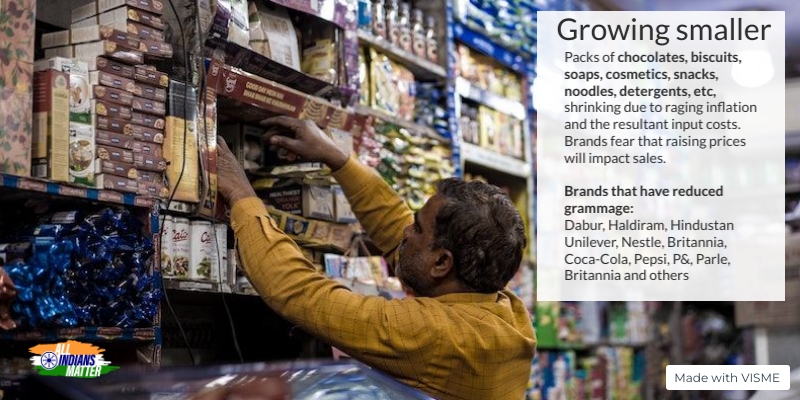Ashraf Engineer
May 28, 2022
EPISODE TRANSCRIPT
Hello and welcome to All Indians Matter. I am Ashraf Engineer.
Does that packet of biscuits you just bought seem lighter than it normally does? And is your soap lasting for fewer days? That pack of noodles you like having seems to be smaller too, doesn’t it? You aren’t imagining things – with no sign of raging inflation being tamed, fast moving consumer goods firms, and others, are reducing the volume or weight of their products. India is a price-sensitive market, so they’d rather not raise prices despite costs soaring on the back of expensive fuel and other raw materials getting costlier by the day. Instead, they’re keeping prices steady while giving you less in every pack. Welcome to ‘shrinkflation’.
SIGNATURE TUNE
Retail inflation surged to an eight-year high of 7.8% in April, while food inflation touched 7.86%. Both were way above the Reserve Bank of India’s tolerance limit of 6%. With no sign of it easing, consumers, struggling to meet household expenses, are circumspect about spending. They are unwilling to pay more for items of everyday use. So, FMCG companies have little choice but to reduce the weight and volume of their products while leaving prices unchanged.
When inflation crosses a certain limit, it burdens not just you and me. It puts incredible pressure on industries. So, industrial production remained weak at 1.9% in March on the back of poor manufacturing sector performance and FMCG companies struggled to keep their heads above the water. While some raised prices, they couldn’t keep doing so and opted to shrink pack sizes instead.
This is ‘shrinkflation’. It’s a term coined by British Economist Pippa Malmgren and means downsizing the size, quantity or quality of the product without increasing its retail price. It’s a strategy that’s becoming increasingly common. Simply put, it means you get less for what you pay for.
With skyrocketing inflation, input costs of products have risen. Knowing that consumers won’t buy their products if they raise prices, companies choose to reduce quality, quantity and size of their offerings in the hope that customers won’t notice. Of course the revised weight or volume is declared on the packaging, but who reads that?
Raw materials like edible oil, wheat especially, packaging material like laminates and corrugated boxes – all of which are used in the manufacture of chocolates, biscuits, soaps, cosmetics and detergents – have been rising since last year.
So, major players like Dabur, Hindustan Unilever, Nestle, Britannia, Coca-Cola, Pepsi and P&G have chosen shrinkflation. Haldiram reduced the weight of its 55-gm aloo bhujia packet to 42 gm. Nestle lowered the weight of its 80-gm Maggi noodles packet to 55 gm. Vim, the popular 10-rupee detergent bar, has gone from 155 gm to 135 gm.
Analysts say that customers rarely notice such changes. This is especially critical at certain price-points. For instance, Re 1, Rs 5 and Rs 10 are “sacred price points” in industry parlance. Any change in the prices of these packets will have a substantial negative impact on sales. Instead, it makes more sense to offer less at the same price. These low unit price points are impossible to give up in a country like India that has so many bottom-of-the-pyramid consumers. That’s why firms choose to protect these price points at any cost.
Here’s how important they are: 30% of Hindustan Unilever’s business comes from packs with these price points. For Britannia, it’s 50%-55% and for Parle Products, which makes the iconic Parle-G biscuits, it’s a massive 70%.
You can’t blame the companies at all; as I said earlier, they’re struggling with insanely high input costs – a result of inflation that has left no raw material or sector untouched. Industry leaders are on record saying their first effort was to absorb the higher costs; shrinkflation set in only when they could no longer afford to do so.
FMCG companies are resorting to another strategy too – ‘bridge packs’. For instance, Hindustan Unilever introduced a size between its Rs 10 and Rs 35 Lifebuoy soaps that many would still be able to afford. It’s trying a similar approach across categories, presumably, to ensure they don’t lose market share.
The Reserve Bank recently tried to hit the brakes on inflation by hiking the repo rate by 40 basis points to 4.40% after leaving it untouched for 45 months. Other countries, such as the US, had hiked rates months ago. The repo rate is the rate at which the Reserve Bank lends money to commercial banks, which in turn give it out as loans to their customers. By raising the cost of funds, the Reserve Bank hopes to reduce demand and thus push down prices. However, the impact of such a rate hike is usually felt six to eight months down the line – if they’re felt at all – and our high-inflation reality isn’t going to change soon.
Now, there are reports that the RBI will hike rates again. This is a tough balancing act because the country isn’t doing well on the economic front. If growth and jobs are to return, businesses need access to cheap funds – the exact opposite of what the rate hike will achieve.
Time will tell where all this will take us. In the meantime, make sure you savour that packet of biscuits you like dunking into your tea and having – even if it’s gotten a little bit smaller.
Thank you all for listening. Please visit allindiansmatter.in for more columns and audio podcasts. You can follow me on Twitter at @AshrafEngineer and @AllIndiansCount. Search for the All Indians Matter page on Facebook. On Instagram, the handle is @AllIndiansMatter. Email me at editor@www.allindiansmatter.in. Catch you again soon.






